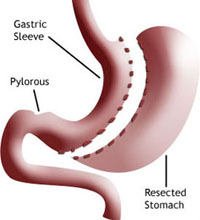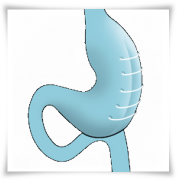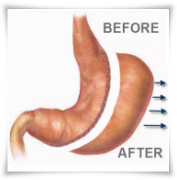About Gastric Sleeve
If you’re looking at options for bariatric surgery, it is significant to get the facts about gastric sleeve surgery since this is the latest innovation in the field of weight loss surgery. The gastric sleeve procedure is also referred to as a laparoscopic sleeve gastrectomy, sleeve gastrectomy, vertical sleeve gastrectomy or VSG, and the tube gastrectomy.
Learning more about gastric sleeve surgery is recommended for those people who are extremely overweight, or are not qualified for other types of weight loss surgery, like the gastric bypass and gastric banding. Health conditions can pose risks and complications with other types of surgery, but if you review info about gastric sleeve surgery, you will see that it is a very simple, minimally invasive procedure for which many patients are suited for.
Click here to read more about the Gastric Sleeve.
About Gastric Sleeve Surgery – How It Works
Here we’ll give you info about gastric sleeve and how it can help you lose weight. Gastric sleeve surgery is a restrictive method of weight loss. Restrictive means that the quantity of food you can ingest at any given time is restricted. Other examples of restrictive surgery are the gastric band, and the gastric balloon. All of these types of bariatric surgery will reduce the capacity of the stomach, which is the main point about gastric sleeve surgery. Limited food intake will result in fewer nutrients and calories to be absorbed by the body, which ultimately leads to weight loss. Restrictive methods of weight loss typically do not alter the digestive system whatsoever, it stays completely intact and you will digest food as normally do, you will just digest less food.
About Gastric Sleeve Surgery – The Procedure
 Here we’ll give you info about gastric sleeve surgery. The gastric sleeve procedure can either be open surgery, or it can be performed laproscopically. The most important thing to know about gastric sleeve surgery is that 60% to 85%of the stomach is removed from the body. This percentage will vary from patient to patient. The stomach tissue is removed in order to reduce the size of the stomach, which will limit the amount of food you can eat at one sitting.
Here we’ll give you info about gastric sleeve surgery. The gastric sleeve procedure can either be open surgery, or it can be performed laproscopically. The most important thing to know about gastric sleeve surgery is that 60% to 85%of the stomach is removed from the body. This percentage will vary from patient to patient. The stomach tissue is removed in order to reduce the size of the stomach, which will limit the amount of food you can eat at one sitting.
The remaining stomach will be formed by your surgeon into a tube shape, or a ‘sleeve’ – this is where the procedure gets its name from, and is the main idea about gastric sleeve surgery – reducing the size of the stomach. After the sleeve has been formed, the surgeon will use surgical staples to seal up the stomach along the side. The incisions will then be sutured and sealed, and you will be transferred to your room for the initial recovery period, which is usually about 48 hours.
What Does Laproscopic Mean?
Laproscopic means that the entire procedure will be done through tiny, key-hole sized incision. This will leave much less scarring than open surgery. This can also mean less blood loss, and less risk to the patient. This is one very good fact about gastric sleeve surgery – that it can be done laproscopically, and is one major reason why many people who do not qualify for other more complicated procedure will qualify for the gastric sleeve.
A tiny camera is mounted on the end of a tube and inserted through the keyhole, which allows the surgeon to see inside the body. This camera will help the surgeon guide the tools with accuracy and precision. Once the camera is in through one incision, specialized tools will be inserted through the other incisions. These tools are also extremely thin, but allow the surgeon to operate efficiently and accurately.
About Gastric Sleeve Surgery – The Staged Approach
When researching more about gastric sleeve, you will find that the procedure can be done as a stand-alone solution, or it can be part of a two step solution. More recently, surgeons have learned more about gastric sleeve, that on its own can be a very effect method of treating obesity. However, there are cases where the patient is morbidly obese, and requires a more complicated procedure. In this case, the gastric sleeve will be part of what we call the Staged Approach. The Staged Approach is performed on those patients that are morbidly obese, and where there are major health risks and complications.
For example, the morbidly obese patient may need a gastric bypass to alleviate the situation, and bring them to a healthy weight, but the gastric bypass is just too risky to perform on that patient in their current state of health. This is another great point about gastric sleeve, it can be performed first in order to bring the patient down to a weight that will pose much less risk when the second surgery is performed. The patient undergoes the gastric sleeve procedure, and then is given time to heal. As time passes, the patient begins to lose excess weight, which means the health risks are reduced, and the risk of complications is also reduced. Once the patient has reached an acceptable weight, the second stage of the treatment is performed, which is the second surgery where a duodenal switch or gastric bypass is done.
The gastric sleeve surgery has proven to be a valuable step in weight loss, especially for those people who are regarded as high risk. With a gastric sleeve, they can lose excess weight without compromising their safety compared to other weight loss procedures. In addition, it will make the second stage much safer for the patient, increasing the chance of success and reducing the life threatening risks. Without the gastric sleeve as the initial phase, the patient will be exposed to major life threatening risks when undergoing a more invasive type of surgery. To make sure that the weight loss method is safe and to avoid some considerable risks, patients must wait 6 to 18 months before proceeding to the next stage.
If you are considering the gastric sleeve as a solution, then you should learn more about gastric sleeve surgery. Here are some Advantages and some Risks of the Gastric Sleeve…
About Gastric Sleeve Surgery – Advantages
Below are some of the advantages you should know about gastric sleeve surgery.
- Food intake is permanently limited
- No Ghrelin production, which means no hunger
- Patients can expect to lose 50% – 80% excess weight within 12 months
- Your digestive system is not changed or altered
- Food will be digested normally
- No objects or apparatus will be inserted into the body
About Gastric Sleeve Surgery – Risks
Here are some of the risks you should know about gastric sleeve surgery.
- Internal Bleeding
- Wound Infection
- Internal Organ Injury/Body part
- Blood Clot
- Pneumonia
- Leakage where the stomach has been stapled
The Gastric Sleeve is an excellent method to lose weight, so talk about gastric sleeve surgery with your doctor or bariatric surgone. The stand-alone method is a relatively new approach, however, it has proven to be very effective thus far. If you are considering bariatric surgery to help you win the fight against obesity, then find out more about gastric sleeve surgery, it is an option you should definitely look at. There is lots of information on this site that will help you learn more about gastric sleeve surgery, or you can speak with your doctor to get facts on other bariatric procedures as well as info about gastric sleeve.

